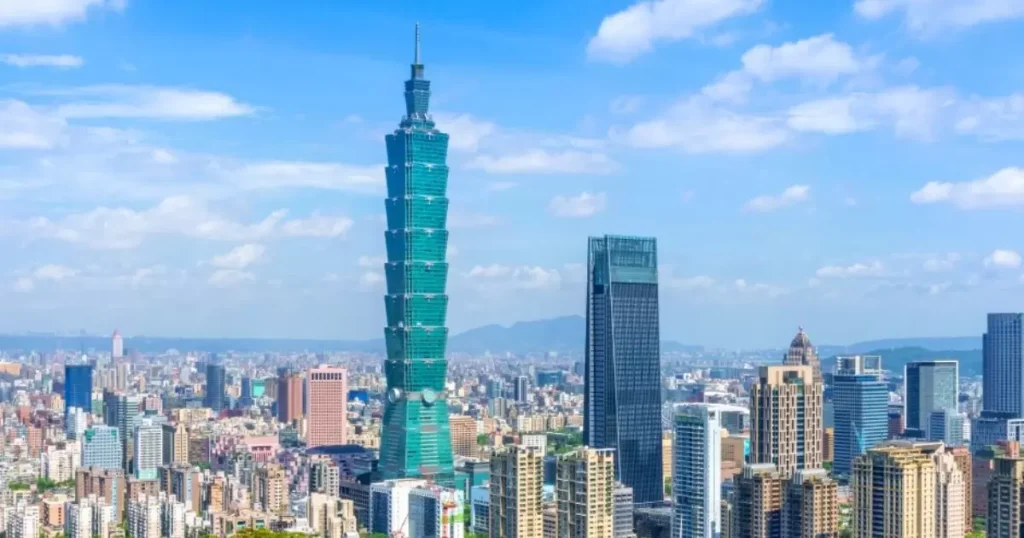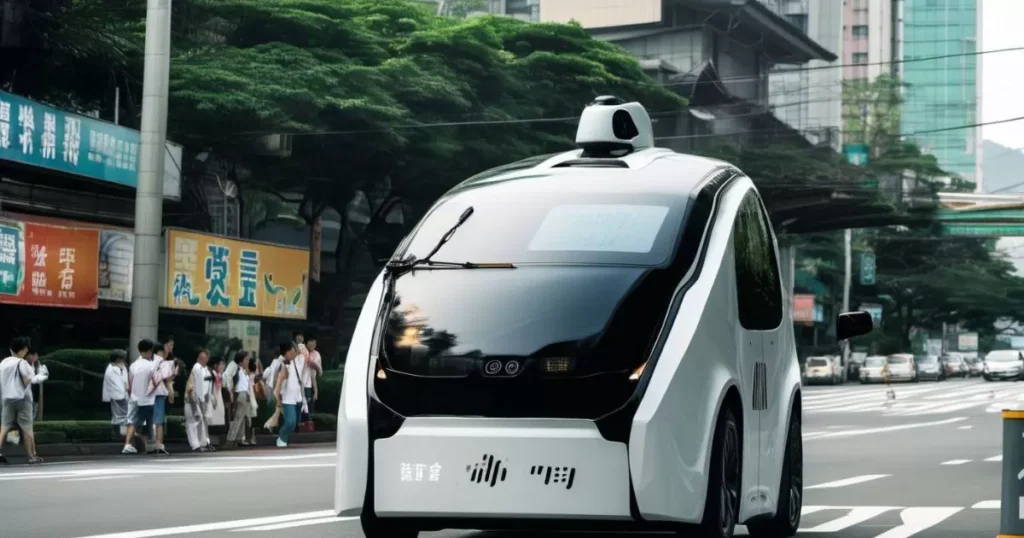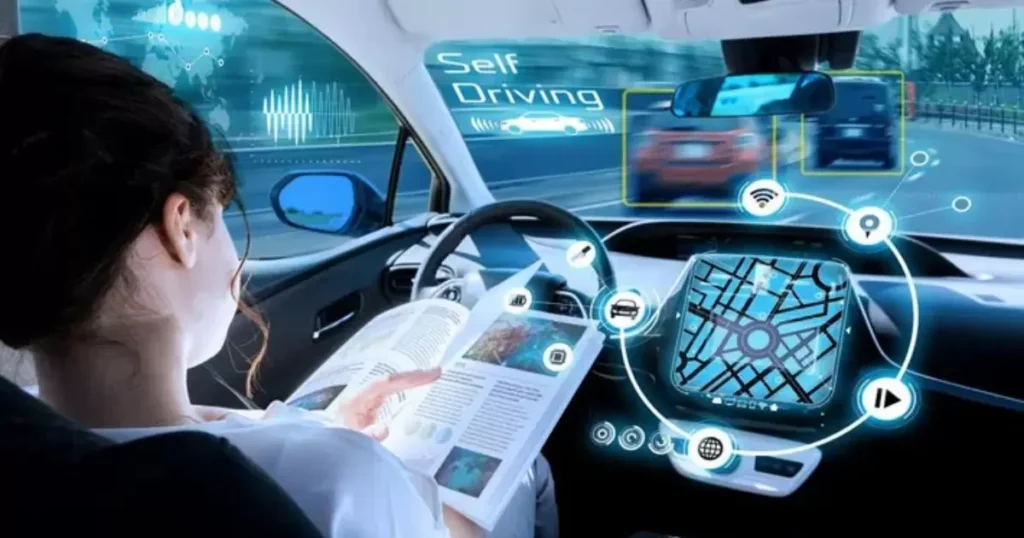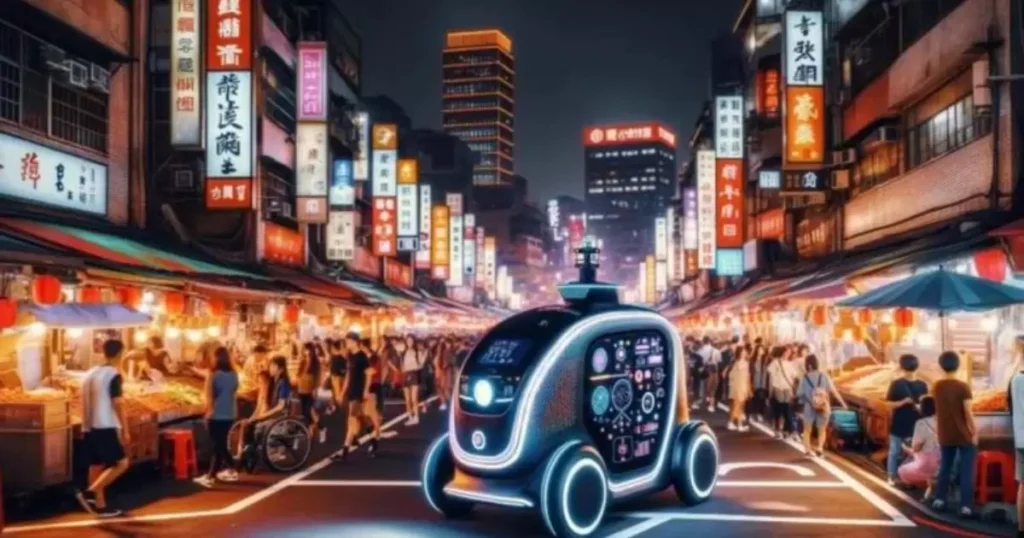Taipei’s self-driving gharries reflect the city’s innovative pride in its cultural roots. The autonomous carriages modernize the 19th century icon with advanced technology like AI programming and top-notch sensors while preserving the decorative archaic style. As the gharries transport passengers through time from Taipei’s glittering skyscraper districts to its ancient temple alleyways, riders witness the unique harmonious balance of past and present. Onboard the self-driving carriages, tourists don’t just sightsee Taipei’s diverse architecture; they immerse themselves in the intersection of rich heritage and progress that permeates Taiwan’s capital. Blending technological brilliance with historical craftsmanship, this pioneering transportation development spotlights Taipei as a model for sustaining cultural traditions even amidst rapid innovation.
What is a Taipei Self-Driving Gharry?

A Taipei self-driving gharry beautifully fuses antiquity with futurism on four wheels. Gharries originated as ornate horse-drawn carriages in 19th century Asia, later becoming an integral emblem of local Taiwanese culture.
With their distinct equine-inspired frames and colorful hand-carved decorations, they came to represent the traditional transport aesthetic of bustling cities like Taipei.
Amidst this vibrant cultural backdrop, the ancient art of Eyebrow Threading also flourished, becoming an integral part of the city’s beauty practices.
However, to sustain this cultural heritage in an increasingly high-tech world, Taipei pioneered a revolutionary innovation – autonomous gharries.
These self-driving incarnations upgrade the classic carriages using modern technology to operate independently.
Features like powerful sensors, AI programming, battery-powered motors, and an internal computerized navigation system allow Taipei’s gharries to now transport residents and visitors without a horse or human driver.
So whether you have a taste for historical architecture or technological wizardry, self-driving gharries perfectly encapsulate Taipei’s harmonious blend of past and future in one unique city icon.
Part transport, part time machine – a ride in one of these carriages provides immersive sightseeing with a progressive twist!
The Gharry: An Emblem of Cultural Heritage
With their distinctive shape and ornate decorations, gharries have long served as rolling symbols of local identity in bustling Asian cities like Taipei.
Originally known as a horse-drawn hackney carriage in the 19th century, gharries became integral to the cultural fabric from India to Taiwan over generations.
Even as taxis and trains modernized urban transit, the slow-moving carriages persisted on Taiwanese streets – continuing to represent the preservation of the past within the present.
Beyond mere vehicles, the ceremonial structures and leisurely pace of gharries came to reflect Taiwan’s living heritage and enduring symbolic value. As such, maintaining their presence against modernization became a priority for sustaining the country’s rich cultural roots.
By creatively outfitting gharries with autonomous technology, Taipei retains the nostalgic vehicles’ legacy while upgrading them for contemporary times.
Residents and tourists can still experience a quintessential piece of old Asia in motion while witnessing how the country ingeniously blends its heritage with cutting-edge innovations.
Whether clip-clopping down rain-slicked side streets or bustling night markets, Taipei’s tech-enhanced gharries enable riders to immerse themselves in Taiwanese history and culture.
How is Taiwan Leading the Way in Innovating this Tradition?

As the first city to implement autonomous functionality in historic gharries, Taipei pioneered a revolutionary way of sustaining cultural heritage within a progressive environment.
By integrating advanced self-driving technology into these ornate horse-drawn carriages, Taiwan struck an artful balance between preserving tradition and embracing innovation.
Their fleet of sensor-equipped electric gharries pays homage to the iconic vehicles’ history while upgrading them for modern metropolitan practicality.
Taiwan accomplished this innovative fusion by prioritizing public safety and experience alongside cultural preservation. Their self-operating gharries navigate bustling streets, narrow alleys, and flowing traffic without compromising on decorative details that showcase heritage.
Instead of relegating such archaic transport to memory, this progressive cultural capital optimized a relic for sustainability via technological creativity.
In doing so, Taipei set an example for metropolises across Asia and the globe for how to simultaneously celebrate the past while looking to the future – a remarkable feat of utilizing modern technology while upholding tradition.
Riding in one of these self-guided vintage carriages provides travelers with a unique chance to soak up Taiwanese history while bearing witness to the nation’s inspiring openness to advancement.
The locally designed system uses:
- Top-notch sensors for navigation
- AI programming to enable autonomy
- Sturdy safety engineering framework
With powerful technology under the hood yet traditional styling on the exterior, Taiwan struck an artful balance between past and future.
Are the Safety Measures in Self-Driving Gharries Trustworthy?
With autonomous functionality being relatively new, especially regarding a historically manual vehicle like the Gharry, it’s reasonable for riders to question its safety.
However, Taipei prioritized security in designing its self-operating carriages. The system relies on powerful sensors to scan terrain, reactive brake features for hazards, and sturdy structural engineering to prevent roll-overs or accidents.
Additionally, self-driving cars include manual overrides for human takeover if needed, along with additional fail-safes. Rigorous Taiwanese testing and protocols minimize risks that could endanger riders or bystanders.
While no vehicle, self-driving or not, is immune to unforeseen circumstances on crowded roads, Taipei’s autonomous gharries prove both innovative and able to transport passengers reliably.
Focusing the pioneering system on both progress and public safety embodies Taiwan’s balanced approach to change with caution.
Exploring Taipei via a Taipei Self-Driving Gharry Adventure

Gliding through Taipei’s dynamic urban landscape in a self-driving gharry provides an utterly unique adventure. As a rider, I could indulge simultaneously in the sights of the modern metropolis and the vehicle’s old-world charm.
My journey wove from the dazzling neon towers of the tech district to shadowy temples and rain-slicked night markets from centuries past. All while enclosed in the ornate carriage styling of yesterday, powered by the autonomous technology of tomorrow.
This juxtaposition spotlights what makes Taipei so magical – the intersection of innovation and tradition that permeates the Taiwanese capital.
Whether gazing at state-of-the-art skyscrapers or antique lanterns from my high-tech carriage window, the self-driving gharry tour revealed to me a city thriving by synthesizing its storied history with an ambitious drive into the future.
Rattling down streets wide and narrow, it felt akin to time travel sprinkled with Taiwanese spice.
Benefits of Self-Driving Gharries for Businesses
Blending innovation with cultural heritage, Taipei’s self-driving gharries unlock surprising business advantages. Beyond tourism, companies can leverage these futuristic models of history for economic and environmental gains. The autonomous carriages sustain the past while powering the future.
- Increased Tourism: Attracts visitors eager for novel AI gharry rides, generating more revenue.
- Preserved Culture: Sustains symbolic icon that encapsulates Taipei’s heritage and identity
- Operational Efficiency: Minimizes costs via self-driving functionality instead of paid drivers
- Eco-Friendly: Conserves environment with electric motors, preventing extinction of tradition
- Inspirational Model: Sets example for respecting heritage within technological progress
- Economic Growth: Proves cultural history can still thrive and profit alongside innovation
- International Attention: Gains global spotlight for ingenious preservation of legacy
- Optimized for same-day deliveries: These autonomous vehicles work round-the-clock, efficiently handling multiple stops in a single journey to save time and resources.”
The ingenious self-driving gharries sustain cultural traditions economically while powering Taipei’s future growth.
Optimal Moments to Enjoy Self-Driving Gharries in Taipei

Experiencing the self-driving gharries in Taipei presents a unique opportunity to witness the seamless integration of tradition and modern technology in one of the world’s most dynamic cities.
The optimal moments to enjoy these autonomous carriages are in the early mornings and late evenings. In the tranquil hours of the morning, the streets of Taipei are less crowded, allowing for a serene ride where one can appreciate the beauty of the city waking up.
The cool, fresh air and the soft light of dawn enhance the experience, making it a perfect time for photographers and nature lovers to capture the city in its most peaceful state.
Late evenings offer a contrasting but equally captivating experience. As the city lights come to life, self-driving gharries provide a magical journey through Taipei’s vibrant streets.
This time is ideal for those looking to explore the city’s nightlife and marvel at the illuminated architecture and bustling night markets.
Riding in an autonomous gharry at night allows passengers to fully immerse themselves in the energy of Taipei without the hassle of navigating through traffic, making it an unforgettable way to experience the city’s charm and innovation.
Women in Technology and Their Involvement in the Gharry Project

Women in technology have played a significant role in the development and success of the Gharry Project, showcasing their expertise and leadership in a field traditionally dominated by men.
Their involvement spans across various facets of the project, including software development, engineering, project management, and user experience design.
These talented women have not only contributed to the innovative aspects of autonomous gharries but have also been instrumental in advocating for inclusive design and accessibility features, ensuring the technology serves a diverse range of users.
Their participation underscores the importance of gender diversity in technology and innovation, highlighting how diverse perspectives can lead to more creative and effective solutions in the tech industry.
Enhancing User Experience and Accessibility Functions
Enhancing user experience and accessibility functions within technology projects has become a crucial focus, aiming to ensure that innovations are inclusive and easily navigable for all users, regardless of their abilities or backgrounds.
This approach involves integrating intuitive design principles, voice-activated controls, customizable user interfaces, and adaptive features that cater to a wide range of physical and cognitive abilities.
By prioritizing these elements, developers can create more empathetic and user-friendly technologies that not only meet the diverse needs of their user base but also foster a more inclusive digital environment.
Such enhancements not only improve the usability of technology for people with disabilities but also enhance the overall user experience, making technology more accessible and enjoyable for everyone.
Conserving the Environment
Conserving the environment has become an imperative global movement, and innovations like the Taipei Self-Driving Gharry are making significant contributions towards this goal.
By leveraging electric-powered autonomous technology, these gharries not only reduce the carbon footprint associated with traditional transportation methods but also promote cleaner, greener urban environments.
Efforts such as these highlight the importance of integrating sustainable technologies into our daily lives, underscoring the role of smart, eco-friendly transportation solutions in mitigating climate change and preserving our planet’s natural resources for future generations.
The Taipei Self-Driving Gharry project exemplifies how technological advancements can align with environmental conservation efforts, offering a glimpse into a future where mobility is both sustainable and efficient.
Economic Benefits
Taipei Self-Driving Gharry offers notable economic benefits, reflecting a pioneering step towards optimizing urban mobility with cutting-edge technology.
This innovation enhances operational efficiency and reduces costs by minimizing the need for human drivers and optimizing route planning, leading to lower fuel and maintenance expenses.
Its initiative stimulates the local economy by fostering technological advancements and creating new opportunities in the burgeoning field of autonomous transportation.
It also positions Taipei as a leader in sustainable urban development, potentially attracting investments and partnerships interested in green technology and smart city solutions.
These economic advantages underscore the transformative potential of the Taipei Self-Driving Gharry project, showcasing how smart mobility solutions can drive economic growth while promoting environmental sustainability.
Top Places to Explore with the Taipei Self-Driving Gharry

1. Taipei 101
Experience the awe-inspiring Taipei 101, once the world’s tallest building. The Taipei Self-Driving Gharry offers a convenient and eco-friendly way to visit this architectural marvel, providing visitors with breathtaking views of the city from its observation deck.
2. National Palace Museum
Delve into thousands of years of Chinese art and history at the National Palace Museum. Accessible by the Taipei Self-Driving Gharry, this museum houses one of the largest collections of Chinese imperial artifacts, offering a deep dive into the rich cultural tapestry of Taiwan.
3. Shilin Night Market
No visit to Taipei is complete without a trip to the Shilin Night Market. The Self-Driving Gharry makes navigating to this bustling market easy, where you can indulge in an array of Taiwanese street food, from bubble tea to stinky tofu and everything in between.
4. Yangmingshan National Park
Escape the city’s hustle and bustle with a self-driving gharry ride to Yangmingshan National Park. Enjoy the serene beauty of its hot springs, hiking trails, and the stunning cherry blossoms in spring, all while contributing to environmental conservation.
5. Beitou Hot Springs
The autonomous gharries provide a stress-free journey to the famous Beitou Hot Springs. Renowned for their therapeutic properties, these natural thermal baths offer a unique opportunity to relax and rejuvenate in a picturesque setting.
6. Chiang Kai-shek Memorial Hall
Visit the majestic Chiang Kai-shek Memorial Hall, a must-see landmark commemorating the former president of the Republic of China. The Taipei Self-Driving Gharry allows for an effortless trip to this important cultural site, where visitors can witness the changing of the guard ceremony and explore the surrounding gardens and museums.
Improving the Customer Experience
It is pivotal in today’s competitive market landscape, and The Taipei Self-Driving Gharry is a prime example of how innovation can significantly enhance service satisfaction.
By integrating advanced technologies such as AI and data analytics, this autonomous transportation solution offers personalized and efficient travel experiences, ensuring seamless interactions from pick-up to destination.
The use of feedback loops to gather passenger insights, combined with the convenience of mobile app integration for easy access and control, showcases a commitment to understanding and meeting customer needs. Innovations like these not only demonstrate how The Taipei Self-Driving Gharry is elevating the urban mobility experience but also how businesses can leverage technology to build lasting relationships and foster brand loyalty through exceptional service.
Present and Future Trends in Self-Driving Gharries

The present landscape of self-driving gharries is marked by rapid technological advancements and increasing adoption in urban environments.
These autonomous vehicles, equipped with cutting-edge sensors, AI, and machine learning algorithms, are revolutionizing the way people commute, offering safer, more efficient, and environmentally friendly alternatives to traditional transportation.
Currently, pilot programs and testing phases are common, aiming to refine the technology and ensure reliability and safety.
Cities around the world are beginning to embrace these vehicles for public transport, delivery services, and even emergency response, showcasing their versatility and potential to alleviate traffic congestion, reduce emissions, and provide accessible mobility solutions.
Looking towards the future, self-driving gharries are poised to become a ubiquitous part of urban landscapes.
As the technology matures and regulatory frameworks evolve, we can expect a broader integration of these autonomous vehicles into daily life. This will likely include a shift towards shared mobility platforms, reducing the need for personal vehicle ownership and further diminishing urban traffic and pollution.
Innovations in vehicle design and infrastructure will accommodate the unique capabilities of autonomous gharries, fostering more efficient and adaptable urban environments.
Furthermore, the integration of smart city technologies with self-driving gharries will enable smoother, more coordinated transportation systems, making cities more livable and sustainable.
As we move forward, the continuous development and adoption of self-driving gharries will play a crucial role in shaping the future of transportation, urban planning, and environmental conservation.
Dealing with Cybersecurity Issues
It has become a critical concern for businesses and governments worldwide as our reliance on digital technologies grows. The proliferation of connected devices and the increasing sophistication of cyber attacks necessitate robust cybersecurity measures to protect sensitive information and maintain the integrity of digital infrastructure.
Organizations are now investing heavily in advanced security technologies such as encryption, firewalls, and intrusion detection systems to safeguard against data breaches, ransomware, and other malicious threats.
Furthermore, there’s a growing emphasis on cybersecurity awareness and training among employees, recognizing that human error often constitutes a significant vulnerability. Regular updates, vigilant monitoring of network activities, and adherence to best practices in data protection are essential strategies in the ongoing battle against cyber threats.
Looking ahead, the challenge of cybersecurity is expected to become even more complex with the advancement of technologies like artificial intelligence (AI) and the Internet of Things (IoT).
These innovations, while offering tremendous benefits, also introduce new vectors for cyber attacks, requiring more sophisticated and dynamic defense mechanisms. The future of cybersecurity will likely see an increased use of AI-driven security solutions, capable of predicting and neutralizing threats before they can cause harm.
Additionally, collaboration across industries and governments will be crucial in developing global standards and protocols to combat cybercrime effectively.
As the digital landscape evolves, so too must our approaches to cybersecurity, ensuring that we can anticipate and mitigate the risks associated with our increasingly connected world.
Opportunity for Expansion
The opportunity for expansion in today’s global market is vast, providing businesses with the chance to reach new audiences, diversify their product offerings, and tap into emerging markets.
With the advent of digital technologies and e-commerce, companies can now operate beyond traditional geographical boundaries, leveraging online platforms to connect with customers worldwide.
This digital shift has lowered entry barriers for smaller businesses, enabling them to compete on a global scale alongside established players. Furthermore, expansion is not just about geographical reach; it also encompasses exploring new industry verticals, innovating product lines, and adopting new business models to meet changing consumer demands.
For businesses willing to navigate the complexities of international markets, including cultural nuances and regulatory challenges, the potential for growth and profitability is significant.
This era of globalization and digital connectivity offers unprecedented opportunities for expansion, empowering businesses to achieve scalability and sustainability in a competitive landscape.
Economic Implications
The economic implications of technological advancements and globalization are profound, reshaping industries, labor markets, and national economies in complex ways.
On one hand, these forces drive economic growth, efficiency, and innovation, offering businesses new opportunities for expansion and consumers access to a wider range of products and services.
However, they also pose challenges, such as job displacement due to automation and increased competition for local businesses facing global players. The digital divide further exacerbates economic disparities, as those without access to digital technologies are left behind.
Policymakers and stakeholders are thus tasked with navigating these implications, balancing the benefits of technological progress and globalization with the need to mitigate adverse effects, such as income inequality and economic instability.
Crafting policies that foster inclusive growth, support workforce reskilling, and ensure fair trade practices is critical to harnessing the positive economic impacts while addressing the challenges of our rapidly changing world.
Self-Driving Transportation: A Sustainable Path or Fleeting Fad?
Self-driving transportation stands at the crossroads of innovation and sustainability, posing the question of whether it represents a lasting shift towards eco-friendly mobility or merely a temporary fascination.
The potential of autonomous vehicles to reduce traffic congestion, lower emissions through optimized driving patterns, and integrate seamlessly with renewable energy sources underscores their promise for a more sustainable future.
By minimizing human error and enhancing efficiency, self-driving technology could significantly decrease the carbon footprint of our transport systems. However, the true sustainability of this path hinges on broader adoption, continuous technological refinement, and the development of supporting infrastructure.
As society deals with the environmental impact of transportation, the development of self-driving vehicles offers a glimpse of a potentially greener, more efficient mode of mobility, provided that it is embraced by comprehensive policies and public acceptance that prioritize long-term ecological benefits over short-term trends.
How Self-Driving Gharries are Shaping Taipei’s Cultural Scene
The introduction of self-driving gharries in Taipei is not only transforming the city’s transportation landscape but also leaving an indelible mark on its cultural scene.
These autonomous vehicles have become mobile canvases for local artists, featuring designs that celebrate Taiwanese heritage and innovation, thus weaving technology into the fabric of Taipei’s rich cultural tapestry.
Beyond their aesthetic appeal, the gharries facilitate greater access to cultural landmarks and events, enabling residents and tourists alike to explore the city’s diverse artistic and historical offerings with unprecedented ease.
They serve as a symbol of Taipei’s commitment to embracing the future while honoring its past, fostering a dynamic environment where tradition and modernity coexist.
This fusion of technology and culture is enhancing community engagement, sparking creative collaborations, and positioning Taipei as a forward-thinking city that values sustainability, accessibility, and cultural expression.
Why Businesses Should Consider Self-Driving Gharries
Beyond wowing tourists, Taipei’s high-tech gharries provide practical benefits for local businesses. Their unique presence attracts visitors eager to ride the novel carriages, increasing tourism revenue. Simultaneously, they maintain the symbolic cultural scenery that characterizes Taipei’s identity and allure.
The autonomous functionality also enables the gharries to operate with minimal human personnel needed, reducing overhead costs. In addition, their eco-friendly electric motors conserve the environment compared to gas-guzzling models while preventing the extinction of a heritage trade.
For companies seeking to sustain local culture while benefiting economically, Taipei’s ingenious self-driving gharries set an auspicious example. The future-forward carriages prove cultural traditions can thrive amidst progress.
FAQ’s
How is driving in Taiwan?
Driving in Taiwan is characterized by busy urban traffic and strict road regulations.
What is an example of self driving?
An example of self-driving is an autonomous vehicle navigating city streets without human intervention.
What is self-driving used for?
Self-driving is used for enhancing road safety, reducing traffic congestion, and improving transportation efficiency.
Is self-driving good or bad?
Self-driving technology has both positive and negative aspects, offering potential safety and efficiency benefits but also posing challenges related to ethics, job displacement, and cybersecurity.
Conclusion
The Taipei Self-Driving Gharry Experience stands as a testament to the harmonious blend of tradition and modernity, offering both locals and tourists an innovative way to explore the rich cultural tapestry of Taipei.
This project not only revitalizes the traditional Gharry, a vehicle pulled by horses, by using self-driving technology, but also underscores Taipei’s commitment to sustainable tourism and technological advancement.
By preserving the historical essence of the Gharry while enhancing it with cutting-edge autonomous driving technology, the project offers a unique, eco-friendly mode of transportation that allows participants to navigate Taipei’s bustling streets and serene landscapes at their own pace.
The experience not only enriches visitors’ understanding of Taipei’s heritage and urban evolution but also serves as a model for other cities aiming to preserve their cultural heritage in the digital age.
Ultimately, the Taipei Self-Driving Gharry Experience exemplifies how tradition and innovation can coexist, providing a blueprint for future endeavors in cultural preservation and technological integration.











